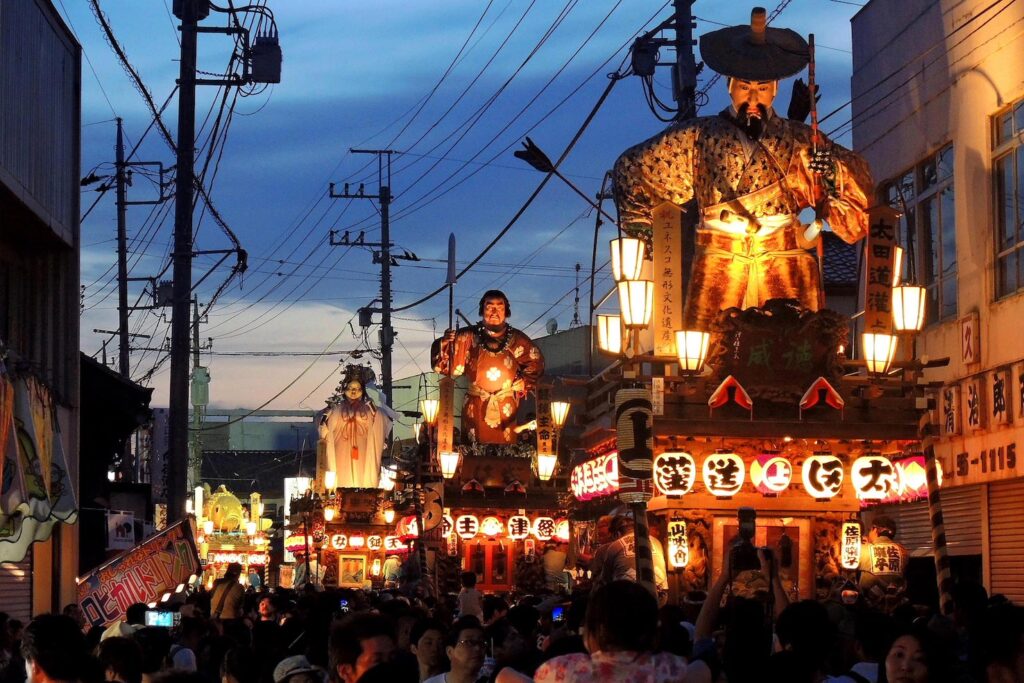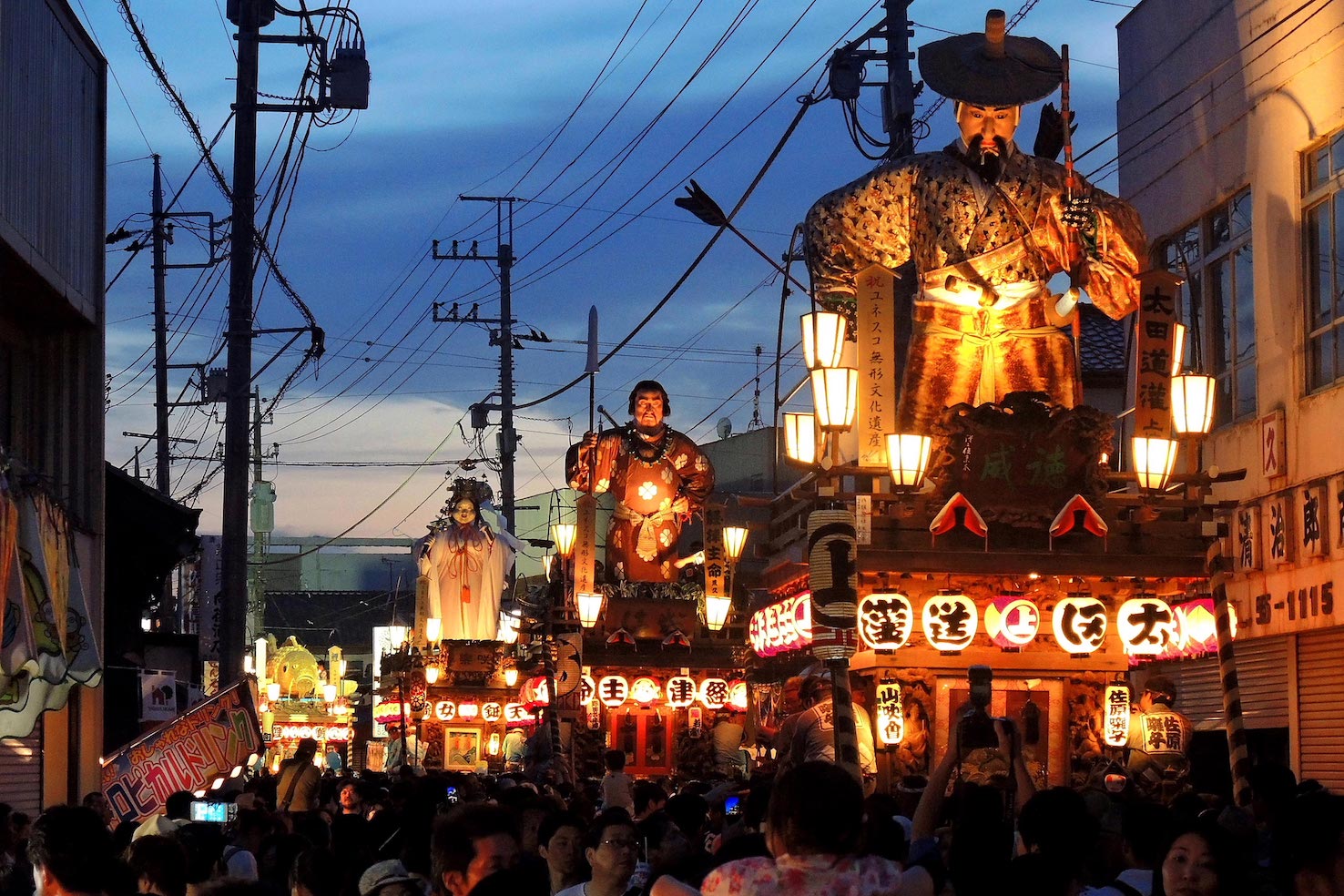
The sound of “Sawara-bayashi,” echoes through the town as the floats skim past the eaves of houses in the townscape known as Koedo (a nationally designated preservation area for traditional buildings), creating a charming atmosphere that is reminiscent of scenes from the Edo period. During the summer festival in July, the Gion Festival of Yasaka Shrine, ten floats are pulled around the area on the east side of the Ono River (in the Honjuku district). On the other hand, during the Suwa Shrine Autumn Festival in October, 14 floats are pulled around the area on the west side of the Ono River (Shinjuku area). This is a wonderful and unforgettable place where I had the opportunity to do fieldwork, score musical accompaniment, and closely observe the district while I was a university student. The Sawara-bayashi, which is played when the floats are pulled, is one of Japan’s three major musical instruments and is designated as an Important Intangible Folk Cultural Asset of Japan.
【by Train】
JR Narita Line Sawara Station
【Highway Bus】Tokyo Station (Yaesu South Exit) → Sawara Station South Exit (105 min.)
・Keisei Bus, Chiba Kotsu
Take Choshi Tokyo Line (Sawara Route or Omigawa Route) from Tokyo Station to Sawara Station North Exit (10 min. walk)
・Kantetsu Green Bus
Departing from Tokyo Station bound for Hokota Station, alight at Sawara Station, etc. 10 min. walk
Sawara Grand Festival(UNESCO Intangible Cultural Heritage)
The main body of the float is made of zelkova (a type of Japanese zelkova) and decorated with massive Kanto carvings. A dynamic “Noji-mawashi” (turning of the character for “noji”) is performed at the intersection in front of the Yamamura Kaikan.
・Summer Festival: Sawara Honjuku District, Katori City
The summer festival is a festival of Yasaka Shrine. 10 floats are pulled around the Honjuku area. (July 15-17, 2022)
Reference : brochure , guide, map
・Autumn Festival : Sawara Shinjuku District, Katori City
Scheduled for October 7-9, 2022
The Autumn Festival is a festival of Suwa Shrine. 14 floats are pulled around the Shinjuku area, and the “Nonoji-mawashi”, a brave and gorgeous “kyokubiki”, is performed here and there.
・Ino Tadataka Memorial Museum : Ino Tadataka Memorial Museum is located in Sawara I, Katori City, Chiba Prefecture, and was established in 1998. The museum houses materials related to Tadataka Ino, such as surveying instruments, surveying maps, and diaries, which are national treasures. It is located across the Ono River from the former residence of Tadataka Ino, a National Historic Site.
OPEN : 9:30AM ~ 4:30PM, closed on Mondays and New Year’s holidays
Admission : 500 yen
・The townscape along the Ono River : Old merchant houses and town houses from the Edo period to the Meiji period stand side by side along the Ono River and the street. 63 buildings of the Edo period and the early Meiji period were built before the great fire of 1892 (Meiji 25), and 70 buildings of the late Meiji period after the great fire are present. Selected by the government as an Important Preservation District for Groups of Traditional Buildings
・Suigo Sawara Float Hall : This is a facility for visitors to learn about the traditions and culture of “Sawara float events” and “Sawara music”, a UNESCO Intangible Cultural Heritage (nationally designated Important Intangible Folk Cultural Property) that is the culmination of the Edo Yuri culture. The museum introduces the essence of the Edo Yuri culture, which has been passed down from generation to generation for about 300 years.
OPEN : 9:30AM 〜 4:30PM, closed on Mondays and New Year’s holidays
Admission : 400 yen
【Stay Over】
Nipponia Sawara : Small-scale decentralized hotel renovated from a mansion in the historical district of Sawara, known as “Edo Masari”Access
【日本語抜粋】佐原の大祭
【背景】日本三大囃子「佐原囃子」の音を町中に響かせながら、小江戸と呼ばれる町並み(国選定伝統的建造物群保存地区)の中を家々の軒先をかすめながら進むさまは風情たっぷりで、江戸時代の情景を彷彿とさせる。八坂神社祇園祭である7月の夏祭りは、小野川をはさんで東側一帯(本宿地区)を10台の山車が曳き廻される。一方、諏訪神社秋祭りである10月の秋祭りは、小野川の西側一帯(新宿地区)を14台の山車が曳き廻される。私が大学在学中、フィールドワークに出かけ、お囃子の採譜をしたり、その地区に密着させていただいた忘れがたい素敵な場所です。山車を引くときに奏でられる佐原囃子は日本三大囃子の一つで、国の重要無形民俗文化財に指定されている。
【交通・アクセス】
電車:JR成田線佐原駅下車
高速バス:東京駅(八重洲南口)〜佐原駅南口 105分
・京成バス・千葉交通 :東京駅発銚子東京線(佐原ルート・小見川ルート)佐原駅北口 下車
・関鉄グリーンバス :東京駅発鉾田駅行佐原駅等で下車 徒歩10分
【観光のポイント】
・佐原の大祭 (ユネスコ無形文化遺産):自慢の山車は、総欅造りの本体に関東彫りの重厚な彫刻が飾り付けられ、上部には江戸・明治期の名人人形師によって制作された高さ4mにも及ぶ大人形などが飾られている。山村会館前交差点で豪快な「のの字廻し」が披露される。
・夏祭り(2022年7月15~17日):香取市佐原本宿地区
八坂神社の祭礼である夏祭りは、本宿地区を10台の山車が曳き廻される。
・秋祭り:香取市佐原新宿地区 2022年10月7〜9日の予定
諏訪神社の祭礼である秋祭りは、新宿地区を14台の山車が曳き廻され、あちこちで勇壮にして華やかな曲曳き「のの字廻し」などが披露される。
・伊能忠敬記念館:伊能忠敬記念館は、千葉県香取市佐原イにある、1998年創立の記念館。
OPEN : 9:30AM ~4:30PM 、月曜・年末年始休館 入館料:500円
・小野川沿いの街並み:江戸時代から明治年間にかけての古い商家や町屋が,小野川や街道沿いに建ち並んでいる。
・水郷佐原山車会館:江戸優り文化の集大成であるユネスコ無形文化遺産(国指定重要無形民俗文化財)「佐原の山車行事」「佐原囃子」の伝統と文化を知ってもらうための施設。
OPEN : 9:30AM ~4:30PM 、月曜・年末年始休館 入館料:400円
【宿泊】NIPPONIA 佐原 :江戸優りと称される佐原の歴史地区の邸宅をリノベートした小規模分散型ホテル。




コメント